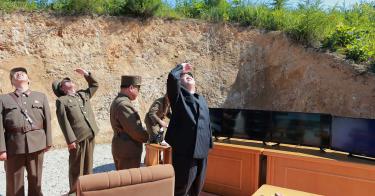The threat is deadly serious.
North Korea’s ominous launch of its first intercontinental ballistic missile on July Fourth means that Pyongyang can reach out and touch the continental United States in a mushroom-cloud sort of way.
According to North Korea’s KCNA news agency, the Hwasong-14 ballistic missile traveled only about 600 miles horizontally — but flew some 1,700 miles vertically, before splashing down in the Sea of Japan.
If the North Korean missile had been launched on a flatter trajectory to extend the distance traveled, the ICBM could have flown some 4,000 miles, according to David Wright, of the Union of Concerned Scientists.
That means that Alaska is within range of the Hwasong-14.
Plus, the new ICBM is a mobile missile, making it more difficult for an opponent to find and, therefore, more survivable in conflict than a system that would be launched from a fixed underground silo or launch pad.
The burning question is whether North Korea has a functional nuclear warhead that can be mated to the ICBM; it’s no easy task miniaturizing — or “weaponizing” — a nuclear weapons testing rig to fit into a missile nose cone.
Once that’s done, North Korea would have to ensure that the re-entry vehicle (that is, the warhead) is able to withstand the harsh elements of intercontinental flight, including heat, vibration, G-forces, etc. so that it in fact goes “Boom!” when it reaches its target.
While KCNA claims that North Korea has achieved at least some elements of this capability, it’s hard for us to know for sure right now. That said, the United States must assume the worst.
Pyongyang will no doubt work to extend the range of its ICBMs to reach all of America (if it isn’t already able to do so now); grow the size of its nuclear arsenal; and develop a survivable, second-strike (that is, retaliatory) capability using ballistic missile submarines.
We clearly can’t stand idly by while it does.
First, our declaratory policy should be that any hostile North Korean military act against us (or our allies) will be met with a proportionate — if not an overwhelming — response.
While even limited U.S. military actions against North Korea could risk another Korean War, we — along with our allies — should engage in regional demonstrations of force (for example, large-scale exercises) to remind Pyongyang what it’s up against.
We must also accelerate our commitment to the development and deployment of robust, multi-layered theater and national missile defenses to protect U.S. territory and interests from North Korean missiles.
Beyond fiery rhetoric and military maneuvers, Kim Jong Un’s regime must feel other forms of heat, too. This could include punitive political and economic sanctions on Pyongyang and its partners.
For example, as has been suggested, we could go after North Korea’s abuse of its overseas workers — from whom it earns upward of $1 billion per year, according to a United Nations estimate — hindering the cash flow to the regime for its weapons programs.
While China and Russia are unlikely to help us with North Korea, we should always keep an eye out for diplomatic opportunities. But the chance that Pyongyang will negotiate on its nukes now is pretty much a nonstarter.
As such, we should deal with North Korea for what it is — a serious and growing nuclear threat to our national security.
This piece originally appeared in The Boston Herald



